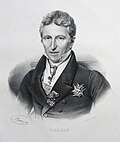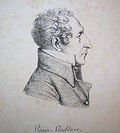Bourbon Restoration
Inaugurating the Bourbon Restoration (1814–1830), a strongly restricted census suffrage elected to the Chamber of Deputies an Ultra-royalist majority (la Chambre introuvable ) in 1815–1816 and again from 1824 to 1827. Known to be "more royalist than the king" (plus royalistes que le roi), the Ultras were the dominant political faction under Louis XVIII (1815–1824) and Charles X (1824–1830). Opposed to the limitation of the sovereign's power under the constitutional monarchy, they hoped to restore the Ancien Régime and annul the rupture created by the French Revolution. Passionately espousing the ruling ideology of the Restoration, the Ultras opposed liberalism, republicanism and democracy. While Louis XVIII hoped for a moderate restoration of the Ancien Régime, acceptable to the masses who had participated in the Revolution, the Ultras held rigidly to the dream of an integral restoration. Their power was due in part to electoral laws which largely favored them: on one hand a Chamber of Peers composed of hereditary members and on the other hand a Chamber of Deputies elected under a heavily restricted census suffrage of approximately 100,000 voters.
In 1815, an Ultra majority was elected to the chamber of deputies. Louis XVIII dubbed them La Chambre Introuvable, "the unfindable chamber", due to his astonishment at a group of deputies more royalist than himself. Under the guidance of his chief minister the Armand-Emmenuel de Vignerot du Plessis, Duc de Richelieu, Louis XVIII finally decided to dissolve this turbulent assembly, invoking Article 14 of the Constitutional Charter. There followed a "Liberal Interlude" from 1816–1820, a period of "wilderness years" for the Ultras. Then on 13 February 1820, the Duke of Berry was stabbed by a republican assassin as he left the Paris Opera House with his wife and died the next day. This outrage strengthened the Ultras, who then introduced laws such as the Law of the Double Vote [ fr ] which allowed them to further dominate the Chamber of Deputies. In addition to other factors, Louis XVIII's health was in serious decline, reducing his resistance to Ultra demands: even before he came to the throne, the Comte d'Artois (Charles X) already dominated the government.
The 1824 death of Louis XVIII, whom they saw as too moderate, lifted the spirits of the Ultras: they expected their leader, the new king Charles X, would soon become an absolute monarch, answerable only to God. In January 1825, Villèle's government enacted the Anti-Sacrilege Act, instituting capital punishment for the theft of sacred monstrance vases (with or without consecrated hosts). This "anachronistic law" (Jean-Noël Jeanneney) was never seriously applied and was repealed in the first months of Louis Philippe's reign (1830–1848). The Ultras also wanted to create courts to punish Radicals and passed laws restricting freedom of the press.
This page is based on this
Wikipedia article Text is available under the
CC BY-SA 4.0 license; additional terms may apply.
Images, videos and audio are available under their respective licenses.



















